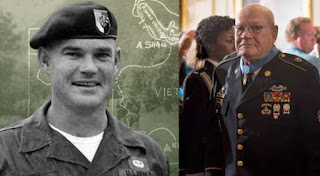This article was originally published on Yellow Hammer News and is written by Cliff Sims .
Bennie Adkins turned 82 on Feb. 1. Exactly 50 years ago, Mr. Adkins was in the jungles of Vietnam. He returned to the United States a legend among Army Rangers, and almost a half-century later was awarded the Medal of Honor for personal acts of valor above and beyond the call of duty during the Vietnam War.
So numerous and heroic were Adkins’ battlefield exploits that President Obama started his remarks at the White House Medal of Honor ceremony by saying that there was no way there would be enough time to describe them all. At another point he paused to simply say, “you can’t make this stuff up.”
Here’s a lightly edited transcript of the official citation, which details a portion of Adkins’ incredible story:
When Adkins’ camp was attacked by a large North Vietnamese and Viet Cong force in the early morning hours of March 9, 1966, Sergeant First Class Adkins rushed through intense enemy fire and manned a mortar position continually adjusting fire for the camp, despite incurring wounds as the mortar pit received several direct hits from enemy mortars.
Upon learning that several soldiers were wounded near the center of camp, he temporarily turned the mortar over to another soldier, ran through exploding mortar rounds and dragged several comrades to safety. As the hostile fire subsided, Adkins exposed himself to sporadic sniper fire while carrying his wounded comrades to the camp dispensary.
When Adkins and his group of defenders came under heavy small arms fire from members of the Civilian Irregular Defense Group that had defected to fight with the North Vietnamese, he maneuvered outside the camp to evacuate a seriously wounded American and draw fire all the while successfully covering the rescue.
When a resupply air drop landed outside of the camp perimeter, Adkins, again, moved outside of the camp walls to retrieve the much needed supplies.
During the early morning hours of March 10, 1966, enemy forces launched their main attack and within two hours, Adkins was the only man firing a mortar weapon. When all mortar rounds were expended, Adkins began placing effective recoilless rifle fire upon enemy positions. Despite receiving additional wounds from enemy rounds exploding on his position, Adkins fought off intense waves of attacking Viet Cong.
Adkins eliminated numerous insurgents with small arms fire after withdrawing to a communications bunker with several soldiers. Running extremely low on ammunition, he returned to the mortar pit, gathered vital ammunition and ran through intense fire back to the bunker. After being ordered to evacuate the camp, Adkins and a small group of soldiers destroyed all signal equipment and classified documents, dug their way out of the rear of the bunker, and fought their way out of the camp.
While carrying a wounded soldier to the extraction point he learned that the last helicopter had already departed. Adkins led the group while evading the enemy until they were rescued by helicopter on March 12, 1966.
During the thirty-eight hour battle and forty-eight hours of escape and evasion, fighting with mortars, machine guns, recoilless rifles, small arms, and hand grenades, it was estimated that Adkins killed between 135 and 175 of the enemy while sustaining eighteen different wounds to his body.
When that last line was read aloud, there was a collective, audible gasp throughout the assembled crowd of friends, family, press and members of the military in the East Room of the White House.
Every member of Adkins’ unit was either killed or wounded during the 48-hour ordeal detailed above. Two of the men he saved were able to attend the event. After the ceremony, Adkins’ thoughts quickly turned to the other heroes with whom he served.
“This Medal of Honor belongs to the other 16 Special Forces soldiers with me,” he said.
President Barack Obama awards the Medal of Honor to Army Command Sergeant Major Bennie G. Adkins in a ceremony at the White House Sept. 15, 2014 (Photo: Cliff Sims)
Medal of Honor recommendations usually must be made within two years of the act of heroism and must be presented within three years. Adkins received his some 48 years after the fact.
So why did it take so long for Adkins to be recognized?
“In 2009, Command Sergeant Major Adkins’ family contacted my office and told us that they were going to try to get this wrong righted,” U.S. Rep. Mike Rogers, Adkins’ congressman, told Yellowhammer.
From that moment forward, Rogers made it his personal mission to make sure Adkins received the honor he was due.
Rogers immediately moved for there to be a review of Adkins’ records. Fortunately, all of the documentation the Army compiled after Adkins’ heroic efforts — including first-hand accounts from American soldiers who are still alive — had been preserved by the Pentagon.
According to the documentation, Adkins was nominated for the Medal of Honor shortly after the battle by his chain of command. In doing that, his commanding officer, who was in the battle with him, wrote a five-page narrative detailing what had happened. The Army then took statements from every soldier who was with him and documented all of the communications that took place during the battle.
But as the recommendation worked its way up the chain of command to the general officer level, they inexplicably decided Adkins’ actions merited the Distinguished Service Cross, the nation’s second highest military honor, rather than the Medal of Honor.
When Congressman Rogers’ office started pushing for the Army to revisit Adkins’ story, there was a treasure trove of original battlefield information still intact.
Command Sgt. Maj. Bennie G. Adkins participating in a press conference just after receiving the Medal of Honor at the White House, Sept. 15, 2014. (Photo: Staff Sgt. Bernardo Fuller)
“You’ve got to get the documentation that supports the review,” Rogers said, explaining the process. “Then the Secretary of Defense has to review it and decide that he would like to see it recommended to the president. After that happened, we had to go back and get an exception to the law, which says that the Medal of Honor must be awarded within three years of the event. So we had to get Congress to pass a law to say this deserves an exception.”
Rogers lobbied his colleagues incessantly.
“There was a lot of resistance, surprisingly,” he said. “But one thing that really helped was that Secretary (of Defense) Hagel was asking for this. He had reviewed it and felt like it was an injustice that needed to be remedied. It finally got passed, but it took several months.”
In addition to lobbying Congress, Rogers also had to make his case to the White House, who would not normally be receptive to the requests of a Republican congressman from Alabama.
“We spent several months pestering the president’s office,” Rogers laughed. “Fortunately they did the right thing.”
“Sometimes even the most extraordinary stories can get lost in the fog of war or the passage of time,” President Obama said. “When new evidence comes to light, certain actions can be reconsidered for this honor, and it is entirely right and proper that we have done so.”
As for the reason why Adkins and other deserving soldiers were not properly honored initially upon their return, Rogers said he was not exactly sure, but believes it could have been a combination of the post-war political climate, as well as prejudice.
“There were clearly some prejudices involved when you look at who was and wasn’t recognized after Vietnam,” he said. “Some folks were of a different race, some folks were a certain religion, and some folks were from the South. So there was some of that involved. It may have been because Bennie was a southern boy. You never know.”
In late September of 2014, all of the efforts of Adkins’ family and Rogers’ office came to fruition. Four of the five living men whose lives were saved by Adkins between March 9 and March 12, 1966 joined him at the White House in a scene that had been a half-century in the making.
Adkins, who usually walks with a cane, rose unassisted and stood at attention as the President of the United States bestowed upon him his nation’s highest military honor. Adkins’ chin quivered ever so slightly as President Obama placed the medal around his neck. His wife of 60 years, Mary, beamed with pride on the front row, smiling as she wiped tears from her eyes.
Adkins snapped off a perfectly formed salute to the crowd before exiting the stage.
“This Medal of Honor belongs to the other 16 Special Forces soldiers with me,” he would later say with genuine humility.
And as the Army Chaplain led the audience in a closing prayer, Bennie G. Adkins of Opelika, Ala., stood once more to honor the One who had always been with him, from the jungles of Vietnam to the East Room of the White House and everywhere in between.























